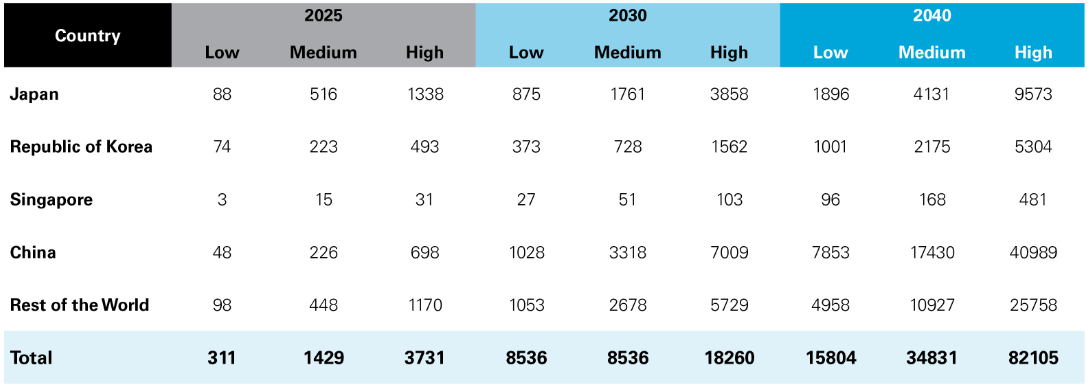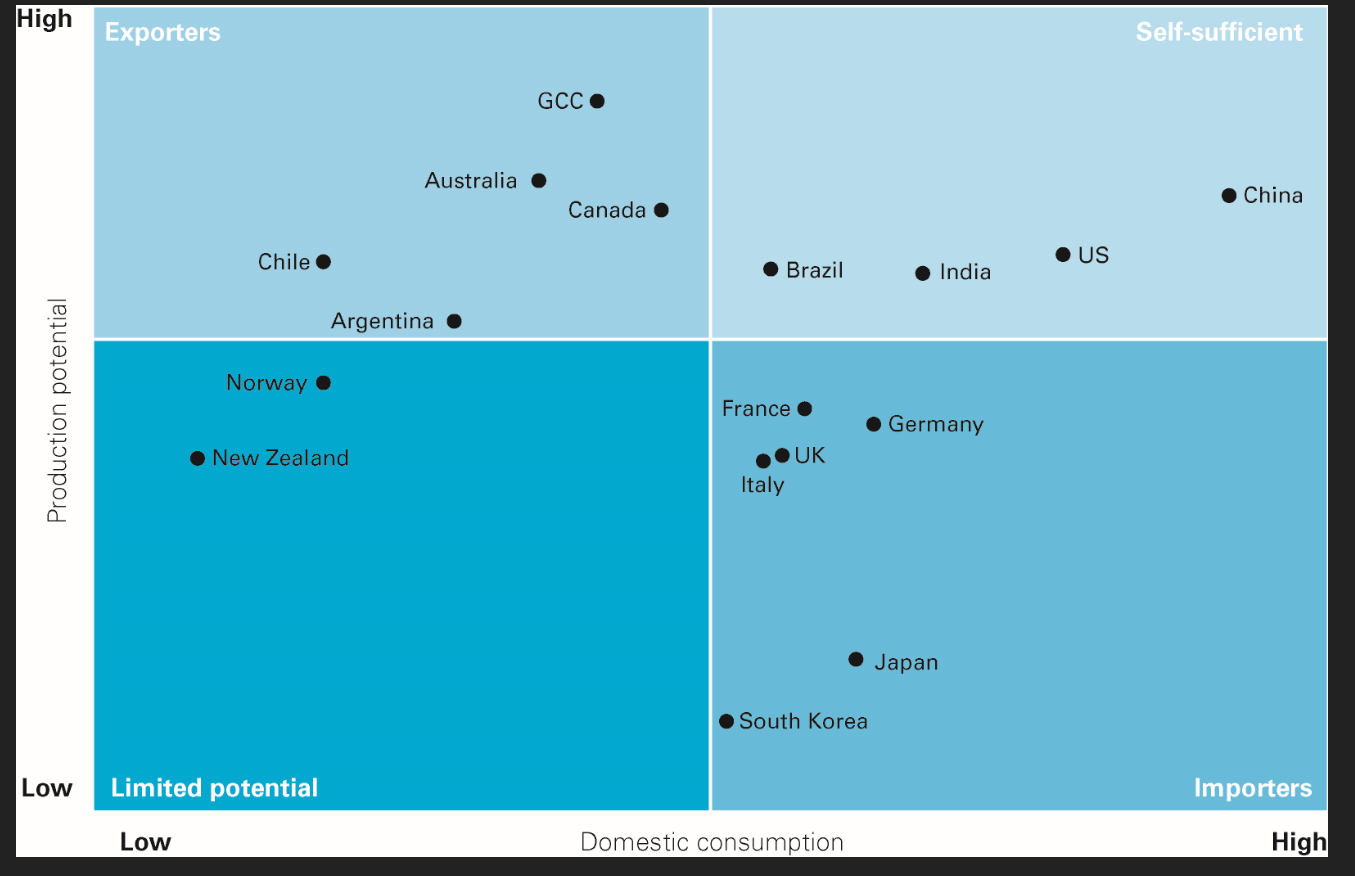
As hype builds around the transformative role hydrogen could play in the clean energy transition, we examine the unique opportunities open to market players in Asia-Pacific. This is the second in a series of three articles on the hydrogen economy.
Hydrogen Economy Series: Part 2
In Part 1 of this Series, we introduced the key concepts underpinning "the hydrogen economy" and explored some of hydrogen's more promising applications in manufacturing, transport and power generation.
In this Part, we look at the state of the hydrogen market today and highlight some recent efforts made by public and private players in hydrogen project development. We also examine the key opportunities and risks from demand- and supply-side perspectives, based on what we are seeing in the market.
Current applications
Most hydrogen today is used in either the petrochemicals industry, where it is used to crack heavier oils into lighter petroleum products, or to produce ammonia for fertilisers. According to BNEF, the vast majority (90%) is produced at sites adjacent to its point of use, largely due to the vast quantities required for consumption and the cost of transportation (given its low density).
The majority of produced hydrogen is 'grey', made from natural gas using steam reformation and resulting in carbon dioxide emissions. According to the International Energy Agency, just over half is produced at dedicated plants, with 41% produced as a by-product of other chemical processes (usually in petrochemical plants and refineries for the uses described above).
The use of solar, wind or other green power sources to produce 'green hydrogen' that could form the foundation of a carbon-free hydrogen economy is, at the time of this article, still in its early stages. Notwithstanding the lack of production today, the International Energy Agency ("IEA") estimates that government spending on hydrogen research and development increased by an average of 4.7% per year in the four years to 2018. China's government led this trend, with research and development expenditure increasing from US$19 million in 2015 to US$129 million in 2018.
The trend appears to be accelerating. In a recent survey of governmental energy budgets, the IEA found the largest increases in 2019 spending came for hydrogen and fuel cells (21% more than 2018 levels). Japan is currently the world's highest funder of hydrogen and fuel cell research, having spent US$303 million in 2019.
Stakeholders in the oil and gas industry advocate for a staged approach to the hydrogen economy, beginning with developing carbon capture and storage ("CCS") to enable production of 'blue hydrogen' from natural gas with carbon dioxide byproduct captured and stored rather than being emitted. Given natural gas is projected to become the world's largest energy source in the mid-2020s, resources companies believe blue hydrogen can be a "bridging" technology before a full transition to green hydrogen. Investment in blue hydrogen would progress important use cases for the hydrogen economy, including unlocking hydrogen's integration with natural gas networks and investment in storage facilities to support grid stabilisation capacities.
Projected Global Demand for Hydrogen ('000 tonnes)
Source: ACIL Allen Consulting
The Hydrogen Pipeline
There is already a strong appetite for hydrogen projects on the supply side. However, cost challenges (see next section) mean that for project development of blue and green hydrogen to be accelerated, large-scale investment and other fiscal support from governments is likely to be crucial.
Australia provides an illustrative example: in April 2020, the Australian Renewable Energy Agency announced up to $70 million in funding to support the acceleration of hydrogen in Australia. After an oversubscribed first stage, seven companies were shortlisted for the final funding round. However, ARENA received 36 expressions of interest for the $70 million funding in respect of renewable hydrogen projects totalling over $3 billion in value.
Several Asia-Pacific governments have made commitments to hydrogen at a federal level. In this section, we highlight some of the key regional developments that have recently emerged.
Japan
In 2017, Japan became the first national government to adopt a national hydrogen framework with its 'Basic Hydrogen Strategy'. The Japanese government has indicated that it sees hydrogen as a crucial pillar in its modern economy as it attempts to reduce its traditional reliance on fossil fuel industries and meet its Paris Agreement commitments through a 26% emissions reduction by 2030. The adoption of this framework was followed by the 'Strategic Road Map for Hydrogen and Fuel Cells' on 12 March 2019, which envisages a high consumption of hydrogen in Japan in the near future. Among other goals, it aims for a full-scale implementation of hydrogen use in mobility starting in 2025 at a reduced cost, with around 800,000 fuel cell vehicles, 1,200 fuel cell buses and 900 hydrogen refuelling stations in place by 2030. The governmentcurrently subsidises fuel cells ranging from residential to industrial use. Japan's initiatives can be expected to intensify following the Prime Minister's announcement of a policy to be carbon neutral by 2050.
Given Japan's potential uses of hydrogen in a variety of industrial uses, power generation and vehicles, together with its comparatively weaker renewable resources and an unfavourable geology for storage, it is likely to be a net importer of hydrogen and has sought to develop international partnerships in pursuit of this goal. In November 2019, a pilot project was announced for the production and transport of hydrogen from Australia to Japan. The Hydrogen Energy Supply Chain proposal, supported by the Australian, Victorian and Japanese governments and several private partners, involves the production of brown (and possibly blue) hydrogen using brown coal deposits in Victoria's Latrobe Valley, to be liquefied and shipped to Japan. Shortly thereafter, the Japanese and Australian governments signed a joint statement of cooperation on hydrogen and fuel cells in January 2020. Japan also received its first shipment of foreign-produced hydrogen from Brunei in late 2019.
At the same time, Japan is producing green hydrogen domestically. A project at the Fukushima Hydrogen Energy Research Field ("FH2R"), which opened in March 2020, can produce green hydrogen from electricity generated from a 180km2 field of solar panels within the FH2R. The water electrolyser installed at the FH2R has the world's largest-class capacity of 10 MW, and is capable of producing enough hydrogen to fill up 560 fuel cell vehicles per day.
The increasing focus in Japan on hydrogen can be seen by the recent establishment of the Japan Hydrogen Association, which is comprised of over 80 Japanese companies and which seeks to accelerate the creation of a hydrogen society.
While this article focuses on developments for production of hydrogen in Asia Pacific, it is noted that there are several test projects between Japan and potential suppliers in the Middle East, including, the world's first shipment of blue ammonia from Saudi Arabia to Japan in September 2020 and the active role being taken by Japan in Oman's new hydrogen roadmap.
South Korea
Similarly, South Korea has made well-publicised plans to decarbonise its economy in recent years, a significant commitment given its modern economy has been built on carbon-intensive processes such as heavy machinery, steel production, shipbuilding and vehicle manufacturing. In 2019, the 'Hydrogen Economy Roadmap of Korea' was unveiled by the government, including a technology strategy which sets long-term targets to 2040. Fuel cell vehicles feature strongly in the strategy: manufacturing giant Hyundai announced its own roadmap in 2018.
In January 2020, the Korean National Assembly passed the Hydrogen Law (Hydrogen Economy Promotion and Hydrogen Safety Management Law), laying the legal foundations for the government's hydrogen commitment and implementing safety standards for facilities. South Korea is also looking for an overseas source of hydrogen in order to consolidate its supply chain. The Korean Ministry of Trade, Industry and Energy is reportedly considering six countries for a role as its hydrogen production base, including Australia, Saudi Arabia and the United States.
China
As part of its latest five-year plan, released in November 2020, China announced a 15-year strategy for new energy vehicles which focuses on developing fuel cell technology for hydrogen-powered trucks and buses. China is already a world leader in government-sponsored hydrogen research and development expenditure (see above), and the Beijing city government has announced plans to have 1,000 fuel cell buses in operation for the 2022 Winter Olympics. Two hydrogen refuelling stations have been opened in Shanghai since 2019, and the central government has declared a target of 1,000 stations by 2030.
While most regulatory efforts to date have been by local governments (rather than the central government), state-backed oil refiner Sinopec announced in October 2020 that it was directing resources towards the development of green hydrogen technology in China, as the nation seeks to reach net zero carbon emissions by 2060.
Australia
Australia is well-positioned to take advantage of these regional commitments to hydrogen demand, given its geographical location and its existing relationships with neighbours in the energy and resources space. Australia has a National Hydrogen Strategy, which aims to scale up Australian hydrogen infrastructure with a set of nationally coordinated actions involving governments, industry and the community.
Despite the fact federal and state governments have yet to make significant fiscal commitments, several large hydrogen export projects have been proposed. As well as its natural resources, Australia has outstanding renewable energy resources – sections of the Western Australian coast, in particular, are blessed with a world-leading combination of sun and wind energy capacity.
The Asian Renewable Energy Hub, a vast potential project in the sunny and windy Pilbara region, is the standout example: 26GW of renewable energy capacity comprised of 1,600 wind turbines and 78 km2 of solar panels, which would be used to power 14GW of electrolysers for green hydrogen production and export. The project was granted 'major project status' by the Australian government in October 2020. However, a growing list of potential projects are being evaluated by private companies at a feasibility stage.
Source: "The dawn of green hydrogen: Maintaining the GCC's edge in a decarbonized world" by Strategy&, part of the PwC network, published 2020.
Singapore
There have been indications hydrogen could form part of Singapore's vision for a carbon-free digital economy. The Australian and Singaporean governments signed a memorandum of understanding on low emissions technology in October 2020, and Singapore announced a $49 million low-carbon research funding initiative as part of the Singapore International Energy Week in the same month.
Given its geographical characteristics, Singapore is likely to be a consumer of hydrogen, not a supplier. An example of this hydrogen demand is the potential floating data centre project between Keppel Data Centres and Mitsubishi Heavy Industries: in April 2020, a memorandum of understanding was signed by the parties to explore the implementation of a hydrogen-powered 'tri-generation plant' (providing heat, power and cooling for the data centres).
India
Several private sector players (including Indian Oil Corporation, Reliance Industries and Adani Group) have called for the energy industry to embrace hydrogen as a clean alternative fuel. To date, the most concerted move by government has been the Ministry of New and Renewable Energy's support of various hydrogen initiatives in research organisations, such as the development of hydrogen-powered combustion engines for small vehicles and the establishment of two hydrogen refuelling stations in Faridabad and Gurugram. The state-run Solar Energy Corporation of India is also reportedly seeking bids for a green hydrogen production plant.
Malaysia
In October 2020, it was announced that SEDC Energy, a subsidiary of state-owned Sarawak Economic Development Corporation, would partner with Japanese companies ENEOS and Sumitomo to conduct a feasibility study into a zero carbon hydrogen supply chain. This was followed by an announcement from national oil & gas giant Petronas that it had signed a memorandum of understanding with Sarawak Energy, an electric utility company, for a large-scale hydrogen production facility.
Vietnam
As part of Vietnam's focus on developing renewable energy resources, the government has encouraged the private sector to investigate hydrogen's role in the national energy mix. Hydrogen's complementary relationship with renewables is the core reason for this push, but the government has also flagged its use in electricity generation in independent power stations.
Europe
While the focus of this article is on Asia-Pacific, several recent announcements in Europe are likely to have a significant impact on the global market for hydrogen. In July 2020, the European Commission announced the EU Green Deal: a sweeping set of strategies to reach net zero emissions by 2050 and further integrate continental energy systems as part of the COVID-19 recovery. One of the two key documents is the Hydrogen Strategy for a Climate-Neutral Europe, which entails spending on increasing electrolyser capacity (up to 40GW by 2030) and new renewable energy generation (up to 120GW by 2030), which is expected to cost a total of €340 billion by 2030 and €470 billion by 2050.
Challenges and opportunities
There is certainly significant hype around hydrogen today, but any fully functioning hydrogen economy is likely to be some way off. In the meantime, potential hydrogen producers and customers are attempting to navigate the likely demand- and supply-side risks inherent with the associated technology.
Hydrogen producers and users have, for a long term, had to address safety concerns, and as the industry scales up, safety will continue to need to be a point of focus. But pressing modern challenges relate to the economics of hydrogen. An exhaustive analysis of these risks is beyond the scope of this article. Nevertheless, in this section we examine three key and interrelated challenges for hydrogen project development : the cost of production, commercial viability (as against, for example, green electricity) and the logistical challenges of transportation and storage. We then turn to the key opportunities zero-carbon hydrogen could unlock in the clean energy transition.
Cost challenges
A key reason the hydrogen economy is not a reality today is the cost of producing green hydrogen – historically, high renewable energy prices and prohibitively expensive electrolysers have rendered large-scale production uneconomic. However, as renewable energy capacity continues to grow, the falling costs of producing renewable energy are a promising sign that green hydrogen production will be viable, provided the cost of electrolysers can follow suit. The signs are encouraging: the cost of electrolysers produced in North America and Europe fell by 40% between 2014 and 2019, according to a recent report on the hydrogen economy by BNEF. Chinese-made electrolysers are already up to 80% cheaper than Western equivalents, but appear to have had lower levels of demand from buyers.
BNEF predicted that if costs continue to fall, green hydrogen could be produced for $0.7 to $1.60 per kilogram in most parts of the world by 2050. At this price, it would be competitive with natural gas on an energy-equivalent basis and would be cheaper than blue hydrogen (produced from fossil fuels and combined with CCS). For this to occur, a ramping up of electrolyser production will be needed and technological improvements to further reduce costs are likely to be required. Subsidies and production incentives may present governments with an opportunity to speed up this process.
Commercial viability
Because hydrogen does not occur naturally and needs to be produced, alternative sources of fuel, heat and feedstock have traditionally enjoyed comparative cost advantages. Historically, this competition has come from fossil fuels, but cheap and widely available renewable electricity is also likely to be a more viable alternative to hydrogen in some sectors (see, for example, the ongoing debate between advocates of battery-powered electric vehicles and hydrogen fuel cell alternatives). Thus, while falling costs of producing renewable energy could help reduce the cost of producing green hydrogen, in sectors where hydrogen competes with renewable energy such falling costs would cut both ways.
Some commentators, such as Michael Liebreich, argue hydrogen sponsors should therefore focus on pursuing uses (and therefore customers) in sectors where hydrogen is likely to have a clear advantage, such as in aviation, shipping and supporting other forms of energy production. In Part 1 of this Series, we explored some of hydrogen's most promising use cases within the array of its potential applications.
Transportation and storage
Due to its low density, hydrogen takes up significant amounts of space and this can create difficulties for transport and storage. In order to be shipped, hydrogen is likely to require liquefaction or conversion into a vector such as ammonia in order for transportation to be economically feasible. These options are expensive. Blue hydrogen production, furthermore, would require significant levels of investment in carbon storage facilities.
Currently, there are three primary means of hydrogen transportation: pipelines, trucks and ships. Piping the gas is the quickest and most cost-efficient means of transport, but large-scale exports of hydrogen are likely to require maritime freight (despite the cost of liquefying the gas or converting it to ammonia). Due to its low density and the cost of liquefaction, the economics of trucking comparatively lower quantities of hydrogen may be cost prohibitive.
Opportunities
The best strategies to combat hydrogen's challenges and unlock its vast potential are still being developed. Notwithstanding the risks identified above, however, much of the research conducted in this space has identified two key elements for early growth: governmental support (in the form of regulatory frameworks, spending and incentives) and targeting the lowest possible cost of production.
Due to the massive sums involved and the certainty required by sponsors and lenders for successful project development, we see the establishment of government incentives and regulatory frameworks as crucial to hydrogen's rise. The growth of hydrogen production capacity (and therefore, the hydrogen economy) can be compared in this way to the emergence of offshore wind project development: many projects in Asia-Pacific, for example, were brought to fruition by deliberate and strategic government programs. Similarly, the growth of the LNG industry will likely be an apt reference point for large scale hydrogen export projects, with government support and long-term offtake contracts with credit worthy buyers being instrumental.
To stave off competition from alternatives, hydrogen must be produced at very low cost. For green hydrogen production, this means the cost of renewable electricity must be sufficiently low and, ideally, easily accessible near to the point of production or via transmission networks. It is for this reason that several hydrogen 'hubs' – including a combination of sun and/or wind power generation, battery storage, electrolyser capacity and export facilities – have been proposed. In a fully functioning hydrogen economy, the price of electricity in such 'hubs' would need to be cheap enough to make the production process economically feasible, and hydrogen would be stored and transported as efficiently as possible.
In the third and final part of this Series, we examine what a regional hydrogen value chain might look like in Asia-Pacific through a hypothetical project development and financing.
Sources:
Bloomberg New Energy Finance, 'Hydrogen Economy Outlook: Will Hydrogen Be the Molecule to Power a Green Economy?', (Report, 30 March 2020).
Michael Liebreich, 'Separating Hype from Hydrogen' (two-part series, October 2020).
Click here to download the PDF of the State of Play: Hydrogen in 2020.
This publication is provided for your convenience and does not constitute legal advice. This publication is protected by copyright.
© 2020 White & Case LLP



